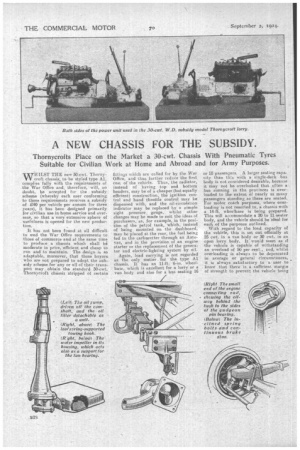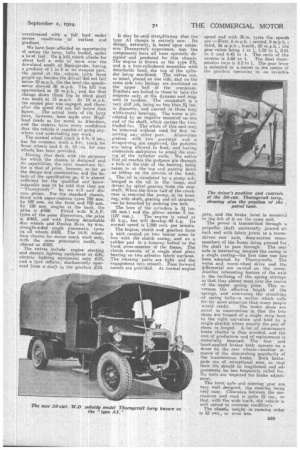A NEW CHASSIS FOR THE SUBSIDY.
Page 10

Page 11

If you've noticed an error in this article please click here to report it so we can fix it.
Thornycrofts Place on the Market a 30-cwt. Chassis With Pneumatic Tyres Suitable for Civilian Work at Home and Abroad and for Army Purposes.
WHILST THE new 30-cwt. Thorny. croft chassis, to be styled type Al, complies fully with the requirements of the War Office and, therefore, will, no doubt, he accepted for the subsidy scheme (whereby each user conforming to those requirements receives a subsidy of £40 per vehicle per annum for three years), it has been designed primarily for civilian use in home service and overseas, so that a very extensive sphere of usefulness is opened for the new production.
It has not been found at all difficult to wed the War Office requirements to those of commerce and at the same time to produce a chassis which shall be moderate in price, efficient and cheap to run and to maintain. The design is so adaptable, moreover, that those buyers who are not prepared to adopt the sub. sidy scheme for any or all of their transport may obtain the standard 30-cwt. Thornycroft chassis stripped of certain fittings which are called for by the War Office, and thus further reduce the first cost of thevehicle. Thus, the radiator, instead of having top and bottom headers, may be of a cheaper (but equally efficient) construction, the ignition control and hand throttle control may be dispensed with, and the oil-circulation indicator may be replaced by a simple sight pressure gauge, whilst other changes may be made to suit the ideas of purchasers, as, for example, in the position of the petrol tank, 'which, instead of being mounted on the dashboard, may be placed at the rear, the fuel being fed to the carburetter through an Autovac, and in the provision of an engine starter or the replacement of the generator and electric-lighting system by oil. Again, load Carrying is not regarded as the only metier for the type Al. chassis. It has an 11-ft. 6-in, wheelbase, which is excellent for a lorry or a van body and also for a bus seating 16 or 18 passengers. A larger seating capacity than ttris with a single-deck bus body is not considered desirable, because it may not be overlooked that often a • bus running in the provinces is overloaded to the extent of nearly as many passengers standing as there are seated. For motor coach purposes, where overloading is not resorted to, a chassis with a 14-it. wheelbase is being prepared. This will aecommodate a 20 to 21 seater body, and the vehicle should be ideal for each of the purposes outlined.
With regard to the load capacity of the vehicle, this is set out officially at 25 cwt, in a van body or 30 cwt. in an open lorry body. It would seem as if the vehicle is capable of withstanding an overload of 50 per cent., and, whilst overloading is always to be deprecated in average or general circumstances, it is always satisfactory to a user to know that there is a sufficient margin of strength to prevent the vehicle being
overstressed with a full load under severe conditions of surface and gradient.
We have been afforded an opportunity of seeing the lorry, fully loaded, under a brief test. On a bill which climbs for about half a, Mile or more over the downland south of. Basingstoke, having a gradient of 1 in 8 at its steepest part, the speed of., the vehicle (with three people up, besides the driver) *did not fall below 10 m.p.h.-On-the level the speedometer showed 30 m.p.h. The hill was approached at 28 m.p.h., and the -first change down (from top to, third gear) . was •made at. 15. m.p.h. At 10 m.p.h. the second gear was engaged, and thereafter the speed did not fall below that figure.. The actual tests of the lorry have, however, been made over Highland roads as far north as Aberdeen, and the makers have every confidence that the vehicle is capable of going anywhere and undertaking any work.
The normal wheel track is 4 ft. 8 ins., but for overseas work a 5-ft. track tom front wheels and 4 ft. 10 ins, for rear wheels has been provided.
Having thus dealt with the purposes for which the chassis is designed and its eapabilities, the next important factor is that of price because, so far as the design and construction and the details of the specification go, it is almost sufficient for the qualified and knowledgeable user to be told that they are "Thornycroft." So we willnow discuss prices. For the standard chassis, fitted with super-cushion tyres 720 mm. by 100 mm. on the front and 720 mm. by 120 mm, singles at the back, the
price Is £450. Fitted with N.A.P. tyres of the same dimensions, the price ie 2463, and with Dunlop detachable disc wheels and Dunlop 36-in, by 6-in. straight-sided single pneumatic tyres on all wheels £488. The 14-ft. wheelbase chassis for motor coach work only, with the same pneumatic outfit, is offered at £523.
The extras include engine starting and electric lighting equipment at £36, electric lighting equipment only £23, and a tyre inflator, mechanically operated from a shaft in the gearbox £10.
It May he said straightaway that the type Al chassis is entirely new. Its design, naturally, is .based upon extensive Thornycroft experience, but. the components have all been specially designed and produced for this, chassis. The' engine is known as the type F13, and is a four-cylindered monobloc with detachable head, the top of the cylinder being machined. The valves are, as usual, placed on one side, and on the same side two facings are machined on the upper half of the crankcase. Brackets are bolted to these to take the magneto only, or the dynamo and magneto. in tandem. The crankshaft is a very stiff job, being no less than 2-I ins. in diameter, and carried in three long white-metal bearings,. The water is circulated by' an impeller mounted on ono end of the shaft, which carries-the twobladed fan. The whole of this unit may be 'removed without need for first removing any other part. Aluminium pistons with two gas-rings and a scraper-ring are employed, the gudgeon Tin being allowed to float, and having aluminium end-pieces to avoid the scoring of the cylinder walls. We notice that oil reaches the gudgeon pin through a hole at the side of the bearing, being taken in at the top and passing down an oilWay on the outside of the hush.
The oil is circulated by a pump submerged in the oil in the sump, and driven by spiral gearing from the camshaft. When the lower half of the crankcase is removed the pump, in its housing, with shaft, gearing and oil strainer, can be detached by .undoing one bolt.
The bore of the cylinders is 3,i 'ins. (95 mm.) and the piston stroke 5 ins. (127 mm.), The engine is rated at 25 h.p., but will develop 40 h.p. Its normal speed is 1,500 revs, per minute.
The 'engine clutch and gearbox form a unit carried on two hearer arms in line with the clutch casing, and on a rubber pad in a housing bolted to the front cross-member of the frame. The clutch consists of a single steel plate hearing on two asbestoa fabric surfaces. The rotating parts are light and the engagement very smooth. Four forward speeds are provided. At normal engine
speed and with 36-in. tyres the speeds are :—First, 6 m.p.h. ; second, 9 m.p.h. ; third, 16 1)3 p. h. ; fourth, 25 m.p.h.; the gear ratios being 1 to 1, 1.58 to 1, 2.61. to 1 and 4.45 to 1. The ratio of the reverse is 5.68 to 1, The final transmission ratio is 6.2 to 1. The gear lever is mounted in a turret in the centre of t w gearbox operating in an invisible
gate, and the brake lever is mounted to the left of it on the same unit.
The power is transmitted through a propeller shaft universally jointed tat each end with fabric joints to a worm. driven rear axle, deep-section crossmembers of the frame being pierced for the shaft to pass through. The rear axle is interesting because thecasing is a single casting—the first time one has been adopted by Thornycrofts. The worm and worm-wheel drive and the differential are carried on the cover. Another interesting feature of the axle is the inclining of the spring stirrups so that they almost meet over the centre of the upper spring plate. This increases the effective length of the springs, and overcomes the stretching of spring bolts—a matter, which calls for far more attention than many people
would credit. The brake shoes are novel in construction in that the two shoes are formed of a single strip bent to the right curvature and held by a single shackle where usually the pair of shoes is hinged. A, lot of unnecessary brake chatter is thus avoided, and the cost of production and of replacement is materially lessened. The foot and hand-applied brakes both operate on a drum on the rear wheels—another instance of the diminishing popularity of the transmission brake. Both brakepads are of exceptional area, so, that their life should be lengthened and adjustments be loss frequently called for. No tools are required for brake adjustment,
The front axle and steering gear are very well designed, the steering being very easy. Clearance between the mechanism and road is quite 12 ins., so that, with -the wide track, the vehicle is well sited to overseas conditiora,
The chassis weight "in running order is 33 cwt., cia even less.






























